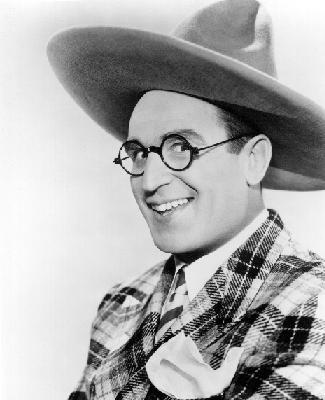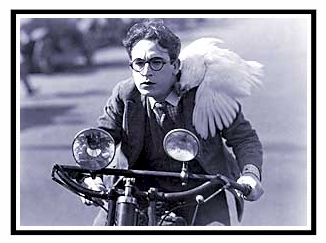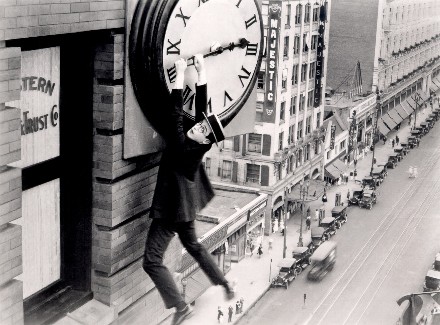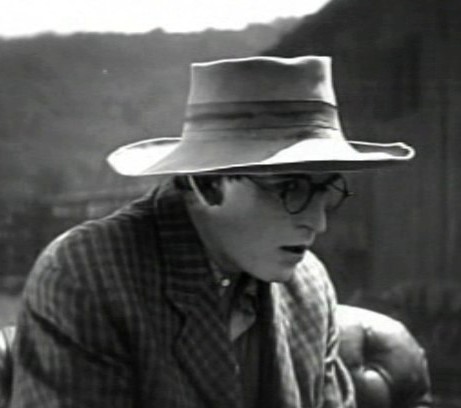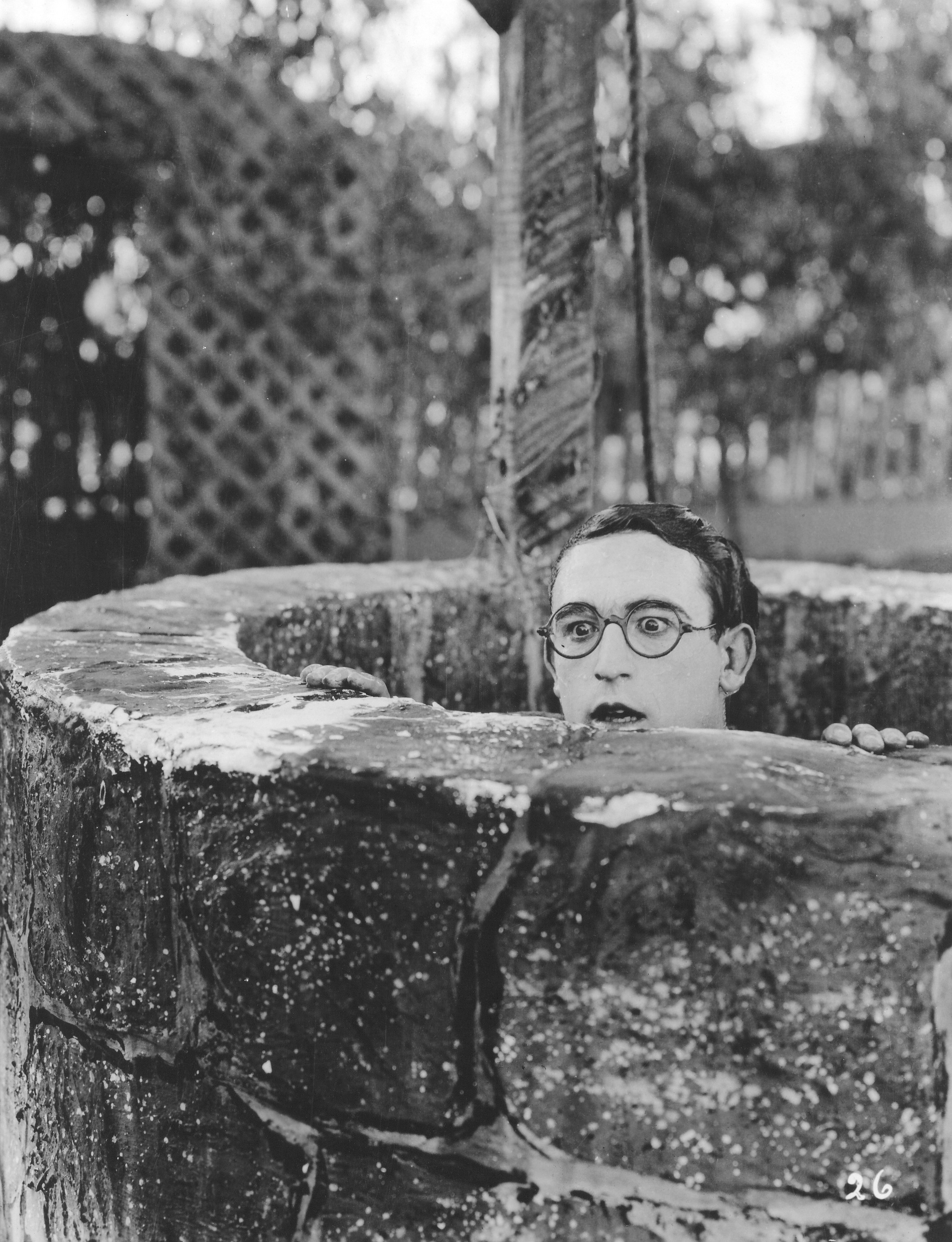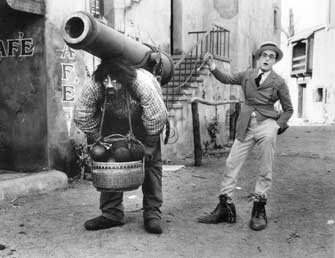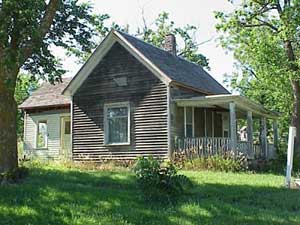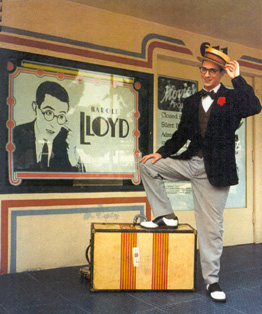 | Harold Lloyd (1893-1971) |
|
|
GIRL SHY(1924) |
|
|
|
|
WHY WORRY? |
|
H.Lloyd photo "Hollywood nuges" |
H.Lloyd''s birthplace in Burchard |
|
Комедии Харольда Ллойда предвещали появление братьев Маркс
Harold Lloyd (1893-1971)
Harold Lloyd, the famous "Man Hanging from the Clockface," is, with Keaton and Chaplin, one of three geniuses of silent era comedy. With his trademark glasses, toothy grin, and character of the 20s, Lloyd became the most popular comedian on the screen, producing more movies than Keaton and Chaplin combined. He created the language of "thrill" comedy, influencing also modern directors and writers. Girl Shy was the model: the innovative techniques, the development of the elaborate and thrilling comic sequences, and the idea process…
Born in Buchard, Nebraska, he received his stage training at the School of Dramatic Art in San Diego. Lloyd had a chronically unemployed father and overbearing mother. He made his stage debut at age 12 as Little Abe in "Tess of d''Ubervilles" with the Burwood Stock company of Omaha. He started on screening in 1913, starting with Edison Company in San Diego, where he first met Hal Roach, who would be the most influential person in his professional life. Then he moved to Universal. In the meantime, Roach had inherited enough money to begin a small production company and contacted Lloyd to star in the kinds of films he wanted to make: comedies. On the basis of self-produced shorts starring Lloyd, he managed to land a production contract with the U.S. branch of the French firm, Pathe, who literally paid Roach by the exposed foot of film. During his first contract with Roach, he appeared in "Will E. Work" and then "Lonesome Luke" comedies, essentially cheap variations of Charles Chaplin''s Little Tramp character. He abandoned the character in 1917, adopting his "glasses" persona, an average young man capable of conquering any obstacle thrown at him.
His new image was in Over the Fence (1917) and in many shorts in 1921, often releasing 3 per month. Roach and Lloyd fought constantly; Lloyd didn''t want to work for anyone. Lloyd had his own quirks. He fell in love with Roach’s first co-star Bebe Daniels. He was also decidedly complex: he had too many hobbies that would include cars, bowling, photography, and high-fidelity stereo systems. He was open minded about homosexuals while being practically Victorian in his ideas about raising his daughters. There were rumors about his illegitimate children.Most traumatically, he suffered the loss of his right thumb and forefinger in an accidental prop bomb explosion on August 14, 1919 - Lloyd spent thousands on flesh-colored prosthetic gloves and hiding his right hand whenever knowingly photographed, even long after his career ended.
He married his second co-star, Mildred Davis, on February 10, 1923, and built a huge 32-room mansion he christened, "Greenacres" that took over 3 years to complete. The couple eventually had 3 children. His final silent film, Speedy (1928), was one of the few major hits of the sound transition period and remains (as do most of Lloyd''s films) thoroughly enjoyable today.
The advent of sound proved problematic for the comedian. His films were gag-driven and his writing team was wholly unaccustomed to converting their type of comedy into dialog. He worked for Paramount and Fox, but it became clear he was in trouble. But he refused to go down without a fight. Amazingly, the public was oblivious to his decline, and he was widely considered as one of the few silent stars to have made a successful transition through the first decade of sound with his The Milky Way (1936). This film actually resulted in a $250,000 loss for the studio. Paramount was livid, demanding a personal guarantee from Lloyd on anything over $600,000 for his next film, Professor Beware (1938). The comedian soon discovered he couldn''t complete the film within the required budget, and he invested his own money. The final production cost was $820,275 - and it grossed a mere $796,385 - and as a result of a complex payment deal, Lloyd ended up personally losing $119,400 on its initial release (he would eventually recoup the bulk of his losses over the next 35 years). At the relatively young age of 45, Harold Lloyd''s Hollywood career was over. He also produced two pictures A Girl, a Guy, and a Gob (1941), and My Favorite Spy (1942) which looked good on paper, but went nowhere at the box office. This ended his career as a producer too.
Still wealthy and always hyperactive, he sought out ways to occupy his time and fell back on his many hobbies. With his career at an end, Harold renewed his interest in photography and became involved with color film experiments. Some of the earliest 2-color Technicolor tests had been shot at Greenacres in 1929 (sadly many of the earliest ones were destroyed in a nitrite fire in a vault at Greenacres in 1943). This ownership gave him the ability to withhold his films from being shown on television; Lloyd feared incorrect projection speed and commercials would damage his reputation. As a result, we saw very few of his films and his reputation was diminished. He did release 2 compilation films, of which the first, World of Comedy (1962) was very successful.
This is the end of Harold’s family story: his wife Mildred descended into alcoholism in the 1950s and died in 1969. Lloyd occupied his time with extensive travel, where he could interact with students on the subject of silent film and continued his pathological passion for his hobbies through the end of his life. He became interested in stereo systems and habitually ordered several record companies'' entire annual catalogs, eventually amassing an LP collection rivaling most record stores. Lloyd was diagnosed with a recurrence of cancer and died on March 8, 1971. His son, Harold Lloyd Jr. was an alcoholic homosexual who died soon afterward. Although Lloyd left an estate valued at $12 million, his son failed to make a provision for the maintenance of Greenacres. His granddaughter Suzanne Lloyd has been largely responsible for restoring his reputation of late, working to preserve his surviving films; many have been issued on HBO Video and Thames Video. Several have been superbly restored with new musical accompaniments and are shown periodically on TCM.
Harold Lloyd was a comic genius of the silent screen and an innovative filmmaker. Lloyd’s character was the “boy next door” in horn-rimmed glasses with undaunted optimism. Among Lloyd’s film masterpieces are The Freshman (1925), The Kid Brother (1927), and Speedy (1928). Even those who have never seen a Harold Lloyd film can recognize him from Safety Last! (1923), hanging from the hands of a clock, on the side of a skyscraper high above a busy city street. The image remains one of the most iconic in American film.
Brother of actor Gaylord Lloyd. Married to actress Mildred Davis 10 February 1923; daughter Gloria Lloyd, born 22 May 1924; daughter Marjorie Elizabeth Lloyd, born 1924 (adopted 1929); son Harold Lloyd Jr., born 31 January 1929; until her death.
Harold Lloyd (1893-1971), the famous "Man Hanging from the Clockface," is, with Keaton and Chaplin, one of three geniuses of silent film comedy. With his trademark glasses, toothy grin, and character that vividly reflected the era of the 20s, Lloyd became the most popular comedian on the screen, producing more movies than Keaton and Chaplin combined. He created the language of "thrill" comedy, influencing not onhis contemporaries, but also modern directors and writers as well - his race-to-the-rescue scene in Girl Shy was the model for the final sequence of The Graduate. This book is a vivid, behind-the-scenes account of Lloyd''s movie making - the innovative techniques, the development of the elaborate and thrilling comic sequences, and the idea process - from his early days in silent film through his work in talking pictures. With glorious, never-before-published photographs, film stills from the archives of the Harold Lloyd Estate and Film Trust, and a text by film historian Jeffrey Vance and Lloyd''s granddaughter Suzanne, the book paints a portrait of a master filmmaker and comedian.
To filmgoers of the 1920s, Harold Lloyd''s image was indelibly shaped by two wardrobe elements: a straw boater hat and a pair of horn-rimmed glasses. Lloyd''s comedy played on this prosaic appearance, turning the ordinary into a comic paradox: the clean-cut young man could triumph over monumental obstacles, even if only by the seat of his white duck pants. During an era of ballyhoo and high spirits, audiences shrieked in laughter and terror as Lloyd hung from the hands of a clock several stories above a busy city street in "Safety Last," his most famous "high and dizzy" comedy.
The theater-mad youth from Nebraska grew up to be a man with serious aspirations. At age 20, with his ultimate goal the Broadway stage, Lloyd went to Los Angeles figuring he could make some easy money as a movie extra. The year was 1913 and a fellow extra with lofty ambitions recognized Lloyd''s talent: Hal Roach, the budding comedy mogul who would later create "Our Gang." Not long after they met, Roach started his own studio. He cast Lloyd in a string of lowbrow slapstick shorts, playing a Chaplin-inspired mischief-maker called Lonesome Luke.
Years after their collaboration, Roach remarked that "Harold Lloyd was not a comedian, but he was the best actor to act the part of a comedian of any person I ever saw." By 1917, Lloyd craved more than being a king of knockabout comedy. He saw a movie that got him thinking: the hero was a mild-mannered, specs-wearing parson who became a capable man of action when provoked. Lloyd reckoned he''d try wearing glasses onscreen.
Walter Kerr, in his book "The Silent Clowns," points out that by developing this character of an unassuming boy who can be aggressive when necessary, Lloyd "fell, almost without thinking, and because of who and what he was, into a myth that already existed: the myth of the good American" who possessed "guts and goodness in tandem."
After testing out his deceptively milquetoast character in dozens of ten-minute one-reel movies, Lloyd tried him out in features. In "Grandma''s Boy" (1922), Lloyd gave his comedic creation dramatic weight. The boy perceives himself as a coward, but learns from his grandmother (who gives him a phony lucky talisman) that courage comes from confidence. But the hapless boy with glasses didn''t have a consistent back story. Over the course of eleven features made during the 1920s, Harold was often a bumbling lad of humble origin who wanted to fit in and make good ("Safety Last," "Girl Shy," "The Freshman"). But sometimes he played a spoiled rich boy who sheds his airs and finds his humanity ("Why Worry?" "For Heaven''s Sake"). Lloyd and his crew of gagmen worked from a loose outline rather than a script, often proceeding backwards from the idea for a climactic set-piece -- the human-fly publicity stunt in "Safety Last," the delightful multi-vehicle race to stop his beloved''s wedding in "Girl Shy," or the comical football game in "The Freshman" -- to flesh out the question of how the character got into a particular predicament.
Lloyd was adept at establishing a bond of sympathy with the audience. In the 1922 "Dr. Jack," he''s a bouncy, selfless doctor who believes in positive thinking. Early on, Dr. Jack examines a freckle-faced boy who''s feigning illness to get out of school. The doctor tricks the boy into revealing his sham, but atones for this snitch by protecting the brat from his furious mother''s spanking (Dr. Jack slips a pillow into the boy''s pants). Both parties end up on the doc''s side, as does the audience.
In "The Kid Brother" (1927), one of Lloyd''s best, Harold holds a Cinderella-like position in an all-male farm household run by his burly sheriff father and he-man brothers. Harold does womanly chores, for which he has invented labor-saving devices. The movie is about proving his manhood, but we''re won over by a moment of sheer boyish charm. In the woods, he meets a beautiful girl from an itinerate medicine show. As she walks back to the encampment, Harold climbs higher and higher up a tree, shouting questions, unable to release her from his sight. The camera, mounted on an elevator, gracefully follows him to the treetop. Love makes Harold resilient, even invulnerable to his inevitable tumble.
For quality and quantity of gags, "Why Worry?" is Lloyd''s funniest. A wealthy hypochondriac sent for a rest cure in South America, Harold strolls into a revolution. Oblivious at first, he eventually becomes engaged with the peasant struggle. In a hilarious variation on taking a thorn out of a lion''s paw, he attempts to pull out a giant''s sore tooth by tying a line around the tooth, throwing the line over a branch, and using his body as a counterweight. Lloyd milks the gag to an elegant conclusion.
"Welcome Danger" (not available for preview) was a turning point. After an initial period during which Lloyd''s fans were curious to hear him speak, his box office figures plummeted. The Depression had come, and the public didn''t want to be reminded of Lloyd''s optimistic go-getter of the boom years. In 1947, Preston Sturges lured him back to the screen for "The Sin of Harold Diddlebock," but the picture was only intermittently funny. Lloyd died in 1971 at age 77.
Not one to cause political controversy or gossip-page scandal like Chaplin, or turn to drink like Keaton, Lloyd sidestepped the stereotype of the angst-ridden funnyman with an agility worthy of his screen self. He was shrewd enough to invest in Beverly Hills real estate and he was only married once, to his leading lady Mildred Davis.
Perhaps Harold''s modesty kept him sane. Lloyd didn''t consider himself an inherently funny person. He worked very hard to craft good comedies that would make people laugh. The greeting that topped a gate to the grounds of his villa-style estate revealed something about the unassuming man who owned it: "Come play with me." Nearly eighty years later, it''s a compelling invitation, and any theater showing his movies is, temporarily, a terrific playground.
Harold Lloyd was a comic genius of the silent screen and an innovative filmmaker. Lloyd’s character was the “boy next door” in horn-rimmed glasses with undaunted optimism. Among Lloyd’s film masterpieces are The Freshman (1925), The Kid Brother (1927), and Speedy (1928). Even those who have never seen a Harold Lloyd film can recognize him from Safety Last! (1923), hanging from the hands of a clock, on the side of a skyscraper high above a busy city street. The image remains one of the most iconic in American film.
After Harold retired from filmmaking, he became obsessed with 3-d photography. For over 20 years he traveled all over the world, taking close to 300,000 slides.
GIRL SHY(1924)
CAST: Harold Lloyd, Jobyna Ralston, Richard Daniels, Carlton Griffin
DIRS: Fred Newmeyer, Sam Taylor
35mm b/w print from The Harold Lloyd Trust
82 mins at 22 fps
The Girl Shy. - Harold plays a man petrified of women who is secretly writing a how-to sex book. The race-against time finale is one of the wildest in movie history. Introducing the program will be Lloyd''s granddaughter, Suzanne and Jeffrey Vance, co-author of Harold Lloyd: Master Comedian newly published by Harry N. Abrams.
Harold Lloyd''s Hollywood Nudes in 3-D is now available. The book was published by Black Dog & Leventhal on Oct. 25, 2004. Harold Lloyd, beloved silent film star, was also an avid 3-D photographer.
In this collection, put together by Harold''s granddaughter Suzanne Lloyd, you will be viewing the photos of his Hollywood nudes taken during the 40s, 50s and 60s. Many of these photos have never been seen before. They are risque and playful portraits of some of Hollywood''s most stunning beauties.
Over the years, Harold photographed more than 5,000 models on his 16-acre Beverly Hills estate, Greenacres. Gorgeous young women were captured lounging in the formal gardens, splashing in the fountains and cavorting through the cypress trees. Every inch of the estate was Harold''s photographic playground and with more than 5,000 women...that''s 312 girls per acre!
The cover art of the book is in 3-D. A huge lenticular image showing a beautiful nude brunette is tastefully covered by floating dots that reveal lettering when viewed at an angle.
The book includes a special pair of paper 3-D anaglyphic glasses shaped like the trademark silent movie round-rimmed glasses Harold Lloyd wore in his silent movies.
Harold Lloyd, beloved silent film star, was also an avid 3-D photographer. After he retired from filmmaking, he became obsessed with photography. For over 20 years he traveled all over the world, taking close to 300,000 slides. Also over the years, Harold photographed more than 5,000 models on his 16-acre Beverly Hills estate, Greenacres. His Hollywood Nudes in 3-D is now available (the book was published by Black Dog & Leventhal on Oct. 25, 2004). In this collection, put together by Harold''''s granddaughter Suzanne Lloyd, you will be viewing the photos of his Hollywood nudes taken during the 40s, 50s and 60s. They are risque and playful portraits of some of Hollywood''''s most stunning beauties.
Lloyd Harold on DVD
The collection
Film frames
VARIETY
Harold Lloyd
